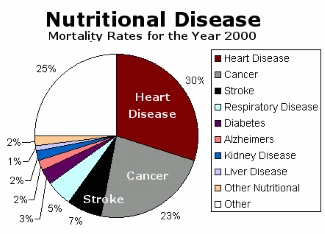
Donabee.com Health & Wellness

|
|
|
|
Recommended Daily Allowance Long ago when the British were sailing the seas, many sailors developed diseases like scurvy. It was eventually discovered scurvy and many other diseases were caused by poor nutrition on the ships. "Diet has always had a vital influence on health. Until as recently as the 1940's, diseases such as rickets, pellagra, scurvy, beriberi, xerophthalmia, and goiter (caused by lack of adequate dietary vitamin D, niacin, vitamin C, thiarnin, vitamin A, and iodine, respectively) were prevalent in this country and throughout the world. Today, thanks to an abundant food supply, fortification of some foods with critical trace nutrients, and better methods for determining and improving the nutrient content of foods, such "deficiency" diseases have been virtually eliminated in developed countries. For example, the introduction of iodized salt in the 1920's contributed greatly to eliminating iodine-deficiency goiter as a public health problem in the United States. Similarly, pellagra disappeared subsequent to the discovery of the dietary causes of this disease." (1) The RDA was developed during World War II by Lydia J. Roberts, Hazel K. Stiebeling and Helen S. Mitchell under the auspices of the National Research Council. The National Research Council determined that a set of dietary standards were needed, especially given the possibility that rations would be needed during the war. The standards would be used for nutrition recommendations for the armed forces, for civilians, and for overseas population who might need food relief. Roberts, Stiebeling, and Mitchell surveyed all available data, created a tentative set of allowances, and submitted them to experts for review. The final set of allowances were accepted in 1941. The allowances were meant to provide superior nutrition for civilians and military personnel, so they included a "margin of safety." In 1997, the Food and Nutrition Board of the National Academy of Sciences did something dramatic: they changed the way nutritionists and nutrition scientists evaluate the diets of healthy people with the creation of the Dietary Reference Intakes (DRIs). Remember the Recommended Dietary Allowances (RDAs)? From 1941 until 1989, the RDAs were established and used to evaluate and plan menus that would meet the nutrient requirements of groups as well as other applications such as interpreting food consumption records of populations, establishing standards for food assistance programs, establishing guidelines for nutrition labeling, to name a few. Their primary goal was to prevent diseases caused by nutrient deficiencies. Technically speaking, the RDAs were not intended to evaluate the diets of individuals, but they were often used this way. Between 1941 and 1989, all of the RDA values were reviewed and published eleven times. Unlike past editions of the RDAs, the new DRI (Daily Reference Intake) values have been released in stages. The first report, Dietary Reference Intakes for Calcium, Phosphorus, Magnesium, Vitamin D and Fluoride, was published in 1997. Since then, seven additional reports have been released which address folate and other B vitamins, dietary antioxidants (vitamins C, E, selenium and the carotenoids), and the micronutrients (vitamins A, K, and trace elements such as iron, iodine, etc). The Recommended Daily Allowance (minimum daily requirement) did what it was suppose to do prevent rickets, pellagra, scurvy, beriberi, etc. But today instead of scurvy and night blindness, we have widespread degenerative diseases like cancer, diabetes, heart disease, etc. Some interesting statistics:
Of the 2.4 million deaths that occur in the United States each year, 75% are the result of avoidable nutritional factor diseases. - former U.S. Surgeon General, Dr. C. Everett Koop Here’s a chart of the nutritional factor diseases cited by Dr. Koop.
Almost all these diseases and many more are the result of nutritional deficiencies. Dr. Ray Strand MD stated that more than 70 of the degenerative diseases that all of us fear are the direct result of years of improper nutrition. What is here:
Some Definitions
(to better understand this) Dietary Reference Intakes (DRIs): There are four types of DRI
reference values: the Estimated Average Requirement (EAR), the Recommended
Dietary Allowance (RDA), the Adequate Intake (AI) and the Tolerable Upper
Intake Level (UL).
Links: Footnotes:
|
![]()
© 2007 Donabee.com - All Rights Reserved Last updated on Monday, November 19, 2007
